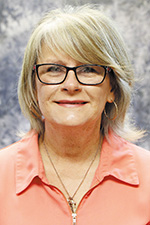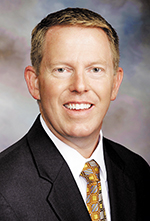Team building, a good work-life balance, town hall meetings and wellness support are all components
Publisher's note: The Arkansas Hospital Association annual meeting is a valuable, resourceful conference for hospital professionals across the state. The 89th meeting and trade show that was held in Little Rock in October was no exception. Arkansas Medical News was there, and we chose to bring takeaways from one of the sessions to our readers. A subject that hits home for many: C-Suite Burnout. We talked to four panelists who participated in the session about strategies to prevent burnout with corporate officers.
Ashley Anthony, CEO, Delta Memorial Hospital, Dumas
Anthony said C-Suite burnout is common in healthcare settings, and it is important to be pro-active about supporting wellness among executives.
"I come from a small, rural, 25-bed critical access hospital," Anthony said. "We have limited C-Suite staff and we all wear multiple hats. I'm not sure you can completely avoid C-Suite burnout. However, I think it is important to talk openly about this on a regular basis with your team. Discuss what the causes are, encourage time off for the staff, and for us, we like to also work on leadership development. A big part of that is self-development and the reasons why we do what we do."
Anthony said one thing she learned from the session is that each facility has its own challenges, and what works well for one is not the answer for another facility.
"You really need to take a deep dive into your own organization, its culture, and community to help you in developing plans to combat burnout," Antony said.
 Kathy Thomas, MSN, Director of Risk Management, Corporate Compliance Officer, White River Health System, Batesville.
Kathy Thomas, MSN, Director of Risk Management, Corporate Compliance Officer, White River Health System, Batesville.
Encouraging top executives to take their paid time off (PTO) is one strategy to keep them mentally healthy.
"Our organization revised our PTO policy for all leaders, director level and higher so that PTO for these leaders can no longer be banked," Thomas said. "It must be used or you lose it by the end of the year. This encourages leaders to take much-needed time off to help prevent burnout. Work-life balance is an important tool for mitigating burnout."
Their team also serves on community service projects, participates in team-building activities off campus, and supports a strong family-first work ethic. They offer on- campus and off-campus fun events with food, activities, and socialization. For some events, staff can bring family.
"We offer town hall meetings with the CEO/C-Suite," Thomas said. "Staff members can ensure their voices are heard. We conduct yearly employee engagement surveys with follow-up meetings to create action items. We have a meditation garden where staff can take their breaks. Our CNO is researching the topic of 'restorative breaks' for the nursing division."
A review of the literature supports that spirituality appears to mitigate cognitive, physical, and emotional burnout. Thomas said their organization offers a voluntary Monday morning prayer time led by a local community church leader for their C-Suite. "Topics weighing heavy on our mind are prayed about during this meeting. I'm not sure how others on our team feel about this," Thomas said. "However, I know my week goes much better when it starts with that meeting. We also offer a voluntary Bible study twice a month, during the lunch hour, led by a local church leader."
 Matt Troup, president and CEO of Conway Regional Health System, Conway
Matt Troup, president and CEO of Conway Regional Health System, Conway
Troup said C-Suite burnout is common in all workplaces.
"Healthcare, in particular, is a field that you are called into," Troup said. "Our staff believe wholeheartedly in our mission to provide high-quality, compassionate healthcare, and we make a promise to be bold, exceptional, and called. With that calling comes the desire to perform at a high-level and be fully immersed in your work."
Troup said they believe that employee happiness and satisfaction stems from feeling fulfilled by your work and heard by your peers.
"For this reason, we implemented quarterly town halls where we come together as a team to share current projects and celebrate accomplishments," Troup said. "It is a wonderful time to share in the great work we are doing, as well as hear suggestions and thoughts on how we might improve. Conway Regional was named a Best Place to Work by Modern Healthcare in 2018 and 2019, as well as an Arkansas Best Place to Work in 2017, 2018, and 2019. Employee benefits such as employee counseling, work celebrations, maternity/paternity leave, and tuition reimbursement lead to a more fulfilled and satisfied staff."
 Vickie Henderson, MD, CMO, Saint Mary's Regional Health System, Russellville
Vickie Henderson, MD, CMO, Saint Mary's Regional Health System, Russellville
Henderson said it isn't possible to talk about C-Suite burnout without talking about physician burnout.
"Whatever affects physicians affects the entire healthcare team," Henderson said. "Revolting against the entire system is unpractical, but neither is yoga going cure a malady that results in turnover, increased medical errors and decreased patient satisfaction. Nevertheless, we need to do something."
The root cause of burnout is multifactorial. Henderson said while the electronic health record (EHR) rises to the top of physician frustrations, it is only a piece of the greater problem.
"In many ways, physicians have been stripped of their role as healer, and demoted to highly-educated clerical workers," Henderson said. "It's not why we went into medicine.
Henderson said whether or not the EHR is the culprit, it isn't going away. Physicians can master it or let it master them. Highly intelligent and pressed for time, they figure out a way to navigate the technology.
"Often it isn't the most efficient way, which fuels frustration in the moment," Henderson said. "The most impactful solution we've found is 'help stations' for the EHR. Cards with a red help button logo are located at every work station. On a daily basis, the cards are collected and a solution is pursued. A stoplight report is regularly shared to let them know what aspects of the EHR they have been able to 'fix' with their suggestions. In addition, there is relentless follow-up to ensure they understand the resolution. Often there's a bit of disconnect between the docs and IT and either the proposed solution is complicated, too tedious or too infrequently utilized to master."
What people need most is to be heard. For that reason, St. Mary's tackled the 'Second Victim' syndrome for all front-line staff. Anytime there is an unexpected adverse outcome, healthcare workers involved are invited to attend a debriefing session. "Recognizing the toll these events take on the emotional health of our staff, counseling is provided," Henderson said. "This primarily consists of talking through the stages of processing the event and validating their feelings. What usually happens next is a spontaneous outpouring of support for all the team members. One necessary component is a box of tissues."
There is no one prescription to treat burnout, but a good place to start is talking about it. "Affirm the existence and impact," Henderson said. "Burnout is not going to be solved with any one action, but action is needed or we all lose."












